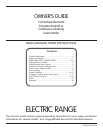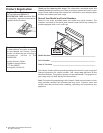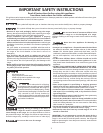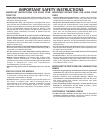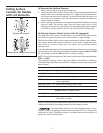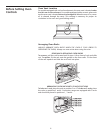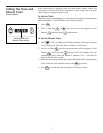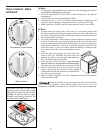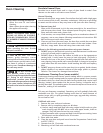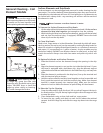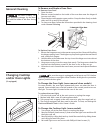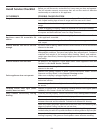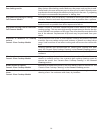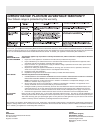
9
Follow these cleaning precautions:
Allow the oven to cool before
cleaning.
Wear rubber gloves when cleaning
the appliance manually.
REMOVE SPILLOVERS AND HEAVY
SOILING AS SOON AS POSSIBLE.
REGULAR CLEANINGS WILL REDUCE
THE NUMBER OF MAJOR CLEANINGS
LATER.
Ammonia must be rinsed
before operating the oven. Provide
adequate ventilation.
DO NOT line the oven
walls, bottom, racks or any other
part of the appliance with aluminum
foil. Doing so will destroy heat
distribution, produce poor baking
results and cause permanent damage
to the oven interior (aluminum foil
will melt to the interior surface of the
oven).
Oven Cleaning
Porcelain Enamel Oven
Porcelain has a smooth finish and is a type of glass fused to metal. Oven
cleaners can be used on all interior oven surfaces.
General Cleaning
Remove soils using hot, soapy water. Do not allow food spills with a high sugar
or acid content (such as milk, tomatoes, saukerkraut, fruit juices or pie filling)
to remain on the surface as they may cause a dull spot even after cleaning.
To Remove Heavy Soil
1. Allow a dish of ammonia to sit in the oven overnight or for several hours
with the oven door closed. Clean softened spots using hot, soapy water.
Rinse well with water and a clean cloth.
2. If soil remains, use a soap-filled scouring pad or a nonabrasive cleaner. If
necessary, use an oven cleaner following manufacturer's instructions. DO
NOT mix ammonia with other cleaners.
3. Clean any soil from the oven frame, the door liner outside the oven door
gasket and the small area at the front center of the oven bottom. Clean
with hot, soapy water. Rinse well using clean water and a cloth.
Adhere to the following precautions when using oven cleaners:
1. DO NOT spray on the electrical controls or switches because it could cause
a short circuit and result in sparking or fire.
2. DO NOT allow a film from the cleaner to build up on the temperature
sensing bulb; it could cause the oven to heat improperly. (The bulb is
located in the rear of the oven.) Carefully wipe the bulb clean after each
oven cleaning, being careful not to move the bulb. A change in its position
could affect how the oven bakes. Avoid bending the bulb and capillary
tube.
3. DO NOT spray any cleaner on the oven door trim or gasket, broiler drawer
glides, handles or any exterior surfaces of the range, plastic or painted
surfaces. The cleaner can damage these surfaces.
Continuous Cleaning Oven (some models)
Continuous cleaning ovens have a special coating which is a porous ceramic
material. This rough coating tends to prevent grease spatters from forming
little beads which run down the side walls leaving streaks that require hand
cleaning. Instead, when spatter hits the porous coating, it disperses and is
partially absorbed. This spreading action increases the exposure of oven soil to
heated air, making it less noticeable.
Soil may not disappear completely. Remaining soil will gradually fade with
continued oven use. The special coating works best on small amounts of
spatter. Larger spills, or spills generating from sugar, egg and dairy mixtures,
do not clean as well.
If difficult soils occur:
1. Remove the oven racks and cookware.
2. Remove soils by completing steps a or b below:
a) Use hot, soapy water and wash soils using a nylon-bristly brush or a nylon
mesh scouring pad. DO NOT rub or scrub with paper towels, cloths or
sponges. They will leave lint on the oven coating.
b) Apply ammonia with a sponge and dab it into the porous coating. Leave
the ammonia on the soiled area for 30 minutes.
3. Rinse with clear water.
4. Close the oven door and push in and turn the Temperature Control knob
to 450°F (230°C).
5. Operate oven for 15 minutes.
6. Remaining soil will fade with continued oven use.
DO NOT use oven
cleaners, gritty cleansers, coarse
abrasive pads or brushes, silicone sprays
or metal scrapers on the interior walls,
oven frame or ceiling of a continuous
cleaning oven. Permanent damage to
the oven may result.



